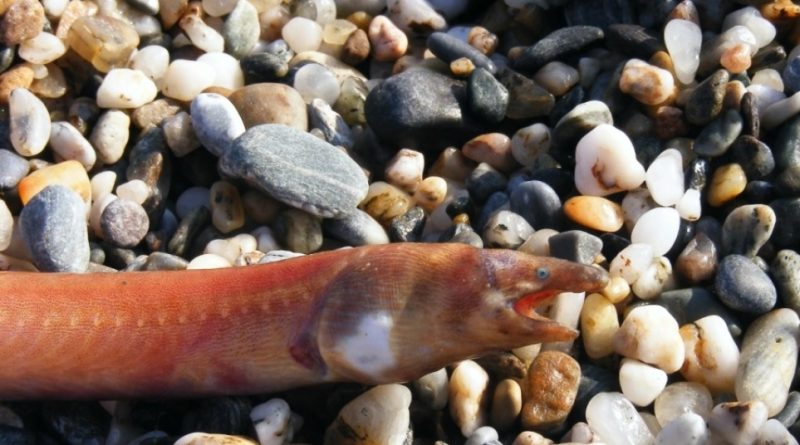Ophichthus rufus
Ophichthus rufus
The rufus snake-eel (Ophichthus rufus Rafinesque, 1810) is a marine bony fish belonging to the Ophichthidae family.
Systematics –
From a systematic point of view it belongs to:
Eukaryota Domain,
Kingdom Animalia,
Sub-kingdom Eumetazoa,
Bilateria branch,
Phylum Chordata,
Subphylum Vertebrata,
Superclass Gnathostomata,
Actinopterygii class,
Subclass Neopterygii,
Infraclasse Teleostei,
Superorder Elopomorpha,
Order Anguilliformes,
Suborder Congroidei,
Ophichthidae family,
Subfamily Ophichthinae,
Genus Ophichthus,
Species O. rufus.
The terms are synonymous:
– Centrurophis remicaudus (Kaup, 1856);
– Echelus rufus (Rafinesque, 1810);
– Ophichthus remicaudus (Kaup, 1856);
– Ophisurus hispanus (Bellotti, 1858).
Geographic Distribution and Habitat –
Ophichthus rufus is a fish found in the Mediterranean Sea, the Black Sea, the North-Eastern Atlantic Ocean, including Algeria, Albania, Croatia, Egypt, France, Cyprus, Gibraltar, Greece, Italy, Israel, Montenegro, Lebanon, Libya, Malta, Morocco, Monaco, Slovenia, Spain, Tunisia, the Syrian Arab Republic and Turkey.
This fish is quite rare in the Italian seas and reported in the Ligurian Gulf, in the Tyrrhenian Sea and in the seas of Sicily.
Its habitat is that of the muddy bottoms of the circalitoral plane between 50 and 300 meters deep, where during the day it burrows into sandy or muddy bottoms.
Description –
The Ophichthus rufus is recognized for having a serpentine body, almost cylindrical, without scales and ventral fins and reaches, at most, 60 cm in males.
It has a yellowish brown color on the back lighter on the belly, the head is finely dotted with reddish brown, while the fins are yellowish white.
The mouth is wide and exceeds the eye by a good distance; the muzzle is rounded, not pointed and the teeth are pointed and turned backwards.
The eye is small and covered with transparent skin.
The anterior nostril has a tubule placed at the tip of the muzzle.
The gill openings are small, located ahead of the pectorals.
The dorsal fin and the anal fin (inserted much further back and much shorter) are interrupted before the caudal extremity of the body, which is finless, pointed and stiff.
The caudal end is blunt pointed.
The dorsal fin is low, especially at the beginning, and ends just before the caudal end, at the end of the anal fin, which is shorter. The pectorals, rounded, are short.
Biology –
The rufus snake-eel, like all fish that live buried in the seabed, has a little known biological cycle; however it is known that it reproduces at the end of summer since, in the Mediterranean, the deposition of the eggs has been recorded from July to October and the larvae are leptocephalic.
Ecological Role –
Ophichthus rufus was described by Constantine Samuel Rafinesque in 1810, originally under the genus Echelus.
This fish, which inhabits the mud sediments on the continental shelf, feeds on benthic invertebrate organisms and small fish.
It is caught with coastal trawls and bottom lines. The meats are good but full of bones, in some areas of Sicily they are used for fish broth.
Due to its wide distribution and abundant population, as well as the lack of major known threats, the IUCN Red List currently lists this fish as Least Concern.
Guido Bissanti
Sources
– Wikipedia, the free encyclopedia.
– GBIF, the Global Biodiversity Information Facility.
– Louisy P., 2016. Guide to the identification of marine fish of Europe and the Mediterranean. Il Castello Editore, Milan.
– Nikiforos G., 2008. Mediterranean fauna. Giunti Editore, Florence.
Photo source:
– https://ecopixeladas.com/ophichthidae-fam-ophichthus-rufus11/
– http://photos.gbif.fr/mnhn_nice/aquarelles_animaux_marins_et_plantes/2005-0-731.jpg


